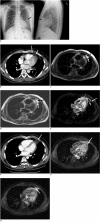MRI findings of pericardial fat necrosis: case report
- PMID: 21603300
- PMCID: PMC3088858
- DOI: 10.3348/kjr.2011.12.3.390
MRI findings of pericardial fat necrosis: case report
Abstract
Pericardial fat necrosis is an infrequent cause of acute chest pain and this can mimic acute myocardial infarction and acute pericarditis. We describe here a patient with the magnetic resonance imaging (MRI) findings of pericardial fat necrosis and this was correlated with the computed tomography (CT) findings. The MRI findings may be helpful for distinguishing pericardial fat necrosis from other causes of acute chest pain and from the fat-containing tumors in the cardiophrenic space of the anterior mediastinum.
Keywords: Fat necrosis; Magnetic resonance (MR); Pericardial fat.
Figures

References
-
- Pineda V, Cáceres J, Andreu J, Vilar J, Domingo ML. Epipericardial fat necrosis: radiologic diagnosis and follow-up. AJR Am J Roentgenol. 2005;185:1234–1236. - PubMed
-
- Chan LP, Gee R, Keogh C, Munk PL. Imaging features of fat necrosis. AJR Am J Roentgenol. 2003;181:955–959. - PubMed
-
- Sirvanci M, Balci NC, Karaman K, Duran C, Karakas E. Primary epiploic appendagitis: MRI findings. Magn Reson Imaging. 2002;20:137–139. - PubMed
-
- Inoue S, Fujino S, Tezuka N, Sawai S, Kontani K, Hanaoka J, et al. Encapsulated pericardial fat necrosis treated by video-assisted thoracic surgery: report of a case. Surg Today. 2000;30:739–743. - PubMed
-
- Webster MW, Jr, Bahnson HT. Pericardial fat necrosis. Case report and review. J Thorac Cardiovasc Surg. 1974;67:430–443. - PubMed
Publication types
MeSH terms
Substances
LinkOut - more resources
Full Text Sources
Medical

